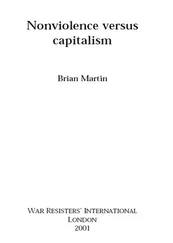This assessment of the link between the state and the military is useful at a general level, but it gives too mechanical a picture. The state is not a unified entity: it contains the government (elected or otherwise), the legal system and various state bureaucracies to run or regulate functions such as welfare, education, industry and transport, among others. It is quite possible for different sectors of the state to promote different goals. Some governments have sponsored studies of social defence; some teachers in government schools have developed peace studies; some government departments have promoted self-reliance; and so forth. It is certainly possible for parts of the state to sponsor nonviolent struggle.
The problem is that nonviolence has a very low profile compared to military approaches. The military is well and truly entrenched, partly because of its structural relation to state power.
Peace activists often hope to sway political leaders by the logic of their arguments. This seldom has much impact, since politicians are much more influenced by power considerations. After all, the threat of global nuclear war has never been enough by itself to persuade politicians to implement nuclear disarmament.
Peace activists also try to apply pressure to political leaders through letter-writing, rallies, mobilisation of voters and civil disobedience. This has a much greater impact than just logical arguments. Nevertheless, there are limitations in the strategy of applying pressure. Political leaders are subject to other pressures, such as lobbying by supporters of the military. Promises are easy to make and easy to break. When community activists seek to get the government to take action, they do not take control of the agenda themselves. Their effort is to get someone else (the government) to take action, not to take action themselves.
Finally, even when governments do take action, they are not likely to promote a process of community mobilisation. They are more likely to sponsor research, which may just delay the day when action occurs. They are likely to provide support for figureheads — such as prominent investigators — rather than for community-level activists.
The experiences with government sponsorship of research into social defence illustrate the above generalisations. Supporters of nonviolent action have devoted much effort to persuading governments to investigate social defence. Occasionally there have been successes. The governments of Denmark, Sweden and the Netherlands have sponsored studies.
The experience in the Netherlands is instructive. [4] . This account, based on discussions with Johan Niezing, is adapted from Brian Martin, “Impressions of the Dutch social defence network,” Nonviolence Today , #34, September/October 1993, pp. 16-18; Civilian-Based Defense , Vol. 8, No. 6, Winter 1993-94, pp. 2-5.
In the late 1970s, a small radical party was part of a coalition government. A member of this party was made science minister, and Johan Niezing, Professor of Peace Research at the Free University of Brussels, was his chief scientific adviser. Niezing has long been committed to social defence, not for idealistic reasons but because it seems to him to be the most pragmatic alternative to the horrors of military methods. [5] . Johan Niezing, Sociale Verdediging als Logisch Alternatief: Van Utopie naar Optie [Social Defence as a Logical Alternative: From Utopia Towards Option] (Assen, Netherlands: Van Gorcum, 1987).
As a result of Niezing’s influence, one of the conditions for continuing the coalition was the acceptance of proposals to fund ten social defence research projects. A committee, chaired by Niezing, was set up to oversee the ten projects. But then there was a change of government. Funding was dramatically reduced so that there was enough for just one project. [6] . One way that this cutback was justified was on the basis of a critique of the Niezing committee proposals by social scientist Koen Koch. For Koch’s views, see Koen Koch, “Civilian defence: an alternative to military defence?” Netherlands Journal of Sociology , Vol. 20, No. 1, 1984, pp. 1-12.
The one project was a study coordinated by Alex Schmid of Leiden University. Schmid and his collaborators concluded that an invasion by a determined military power (specifically, the Soviet Union) could not be stopped by nonviolent means. [7] . Alex P. Schmid, in collaboration with Ellen Berends and Luuk Zonneveld, Social Defence and Soviet Military Power: An Inquiry into the Relevance of an Alternative Defence Concept (Leiden: Center for the Study of Social Conflict, State University of Leiden, 1985). I reviewed it in Civilian-Based Defense: News & Opinion, Vol. 4, No. 4, May 1988, pp. 6-11.
In retrospect, now that the Soviet threat to western Europe has collapsed in the wake of the largely nonviolent 1989 revolutions in Eastern Europe, this analysis seems quite shortsighted. Thus ended a promising possibility for sustained research on social defence.
(Schmid went on to set up the Interdisciplinary Research Project on Root Causes of Gross Human Rights Violations, with the Dutch acronym PIOOM, at the University of Leiden. This is a vitally important social science enterprise, whose core funding remains precarious.)
The Niezing committee was disbanded in 1987; its original proposals, having been updated and augmented by Giliam de Valk, were published in English in 1993. [8] . Giliam de Valk in cooperation with Johan Niezing, Research on Civilian-Based Defence (Amsterdam: SISWO, 1993). The proposals were sketched in chapter 4.
Niezing himself played a key role in ensuring that this publication took place.
These problems with getting governments to take action serve as a warning. It may be worthwhile to seek government support for nonviolent struggle, but it is wise to be aware of the difficulties. For example, at the United Nations, the most powerful governments obstructed a study of military science and technology at every stage. The study was endorsed by the General Assembly, but hamstrung by committee members (selected by governments) who were military officers or just ignorant. The study was held back by governments’ refusals to provide information or their antagonism to critical comment, and was continually stalled at the publication stage. [9] . Ulrich Albrecht, “The aborted United Nations study of the military use of research and development: an editorial essay,” Bulletin of Peace Proposals , Vol. 19, Nos. 3-4, 1988, pp. 245-259. I thank Mary Cawte for finding this reference.
The difficulties that could confront active efforts to develop technology for nonviolent struggle — which might, after all, be used against government repression — can be imagined.
In summary, government support for nonviolent struggle offers the immense advantages of legitimacy and resources. But in most cases there is likely to be great difficulty in gaining any support in the first place, due to the close connection between the military and the state. Furthermore, seeking government support has the disadvantage of trying to get others to take action rather than doing it oneself. Finally, governments are likely to sponsor research that is removed from the community.
All these features are apparent in the Dutch experience. The Netherlands government had ample resources to investigate and promote social defence, but the major political parties were not interested. It was only by a quirk of politics that government funds were allocated to social defence. The money was cut back at the first opportunity and in any case was devoted to research rather than community action. Even so, the funding gave considerable credibility to social defence and the proposals from the Niezing Committee are a valuable resource for future research and action.
Читать дальше












